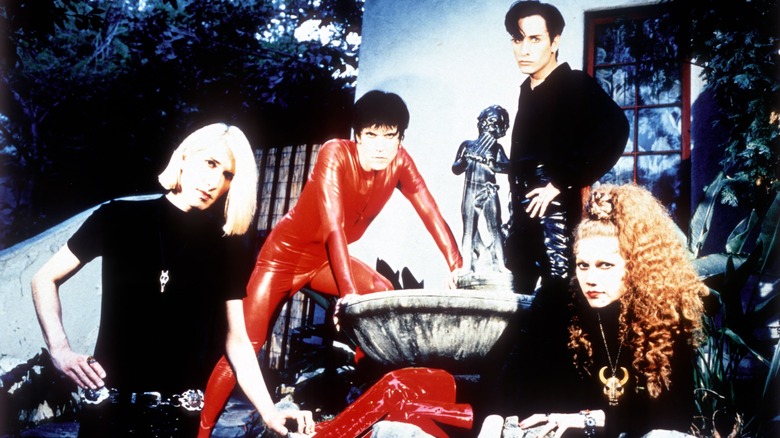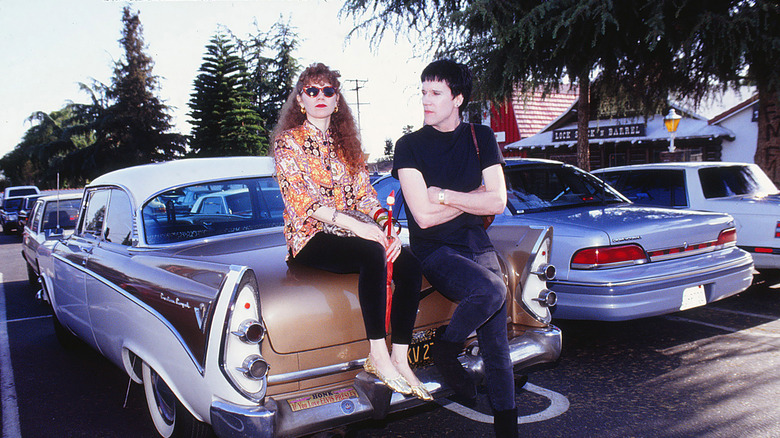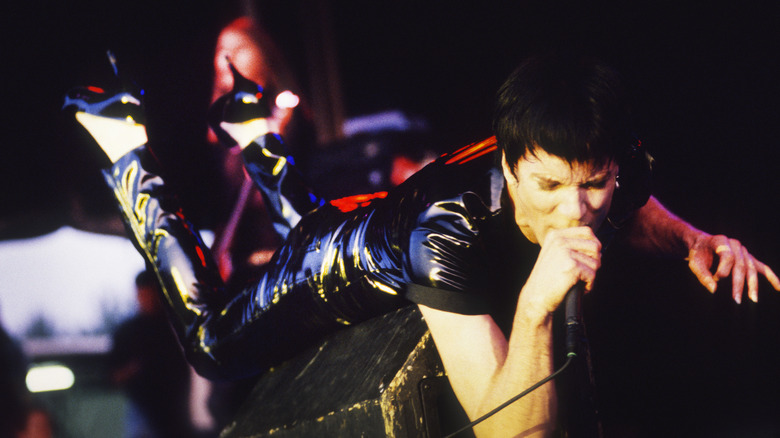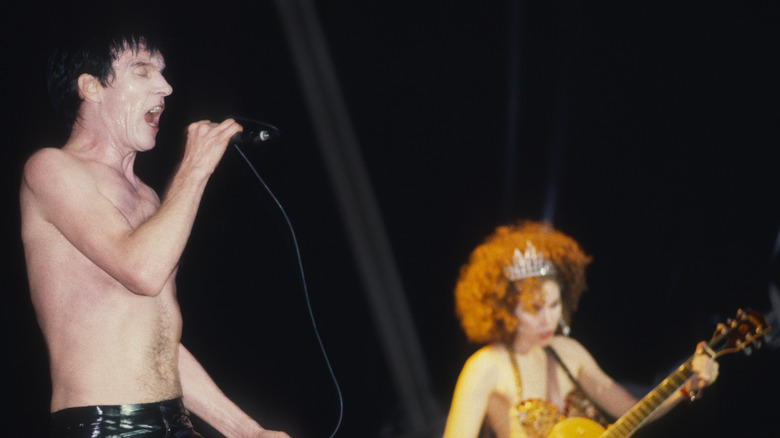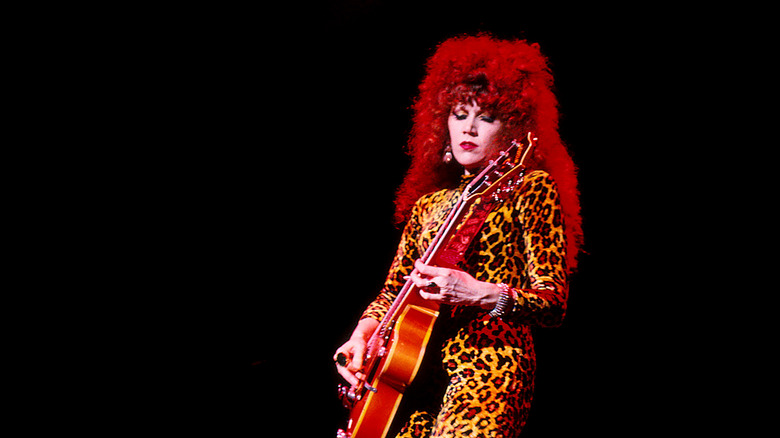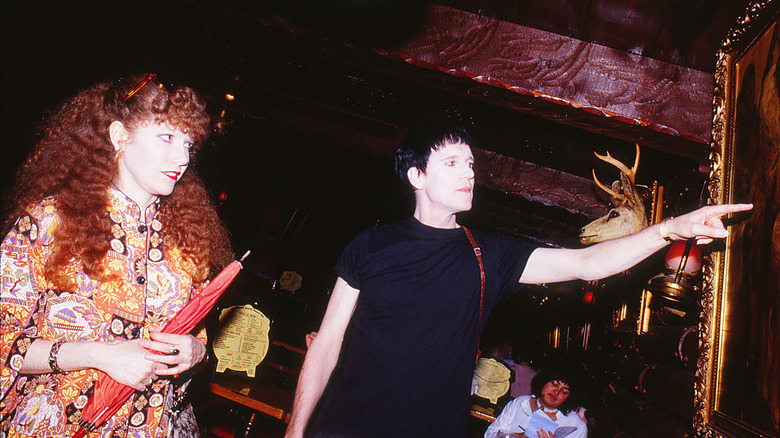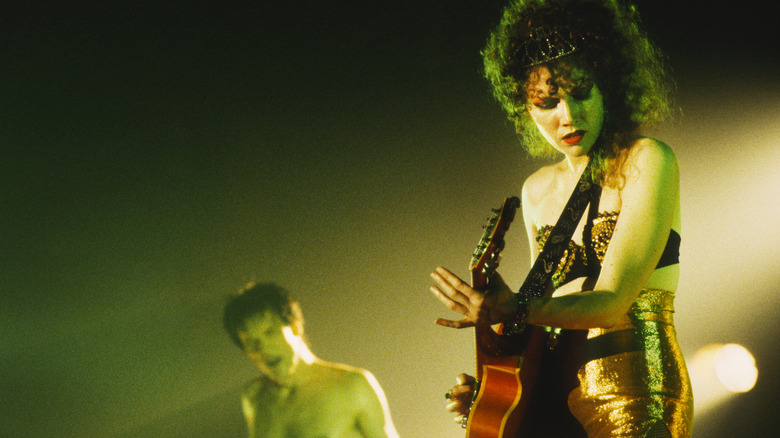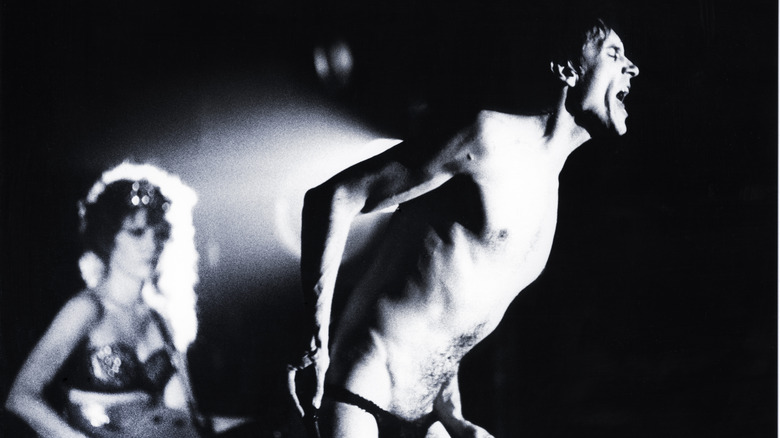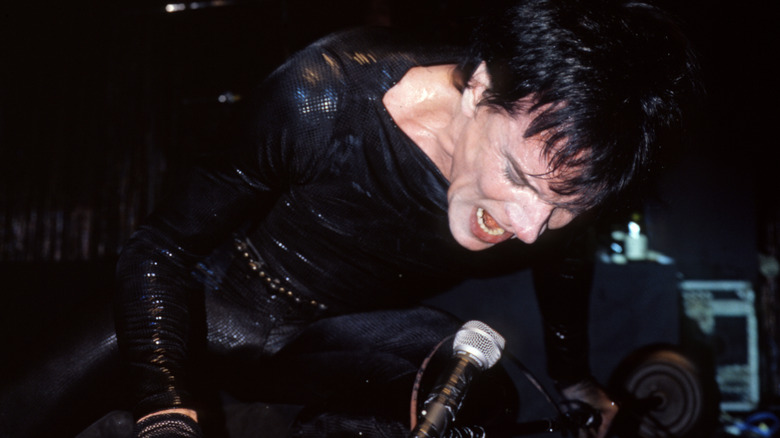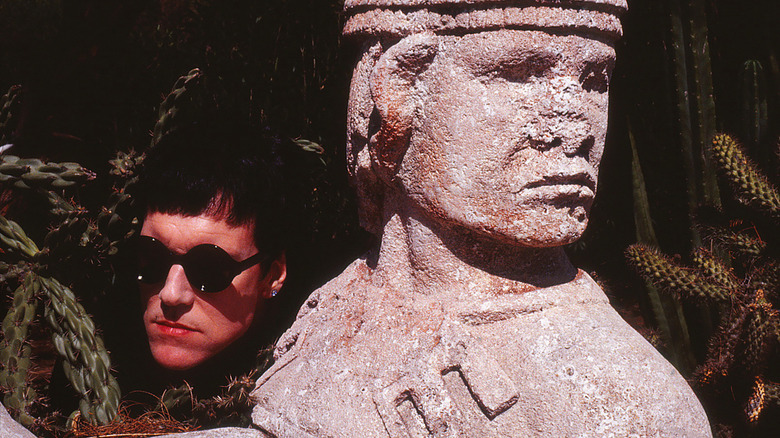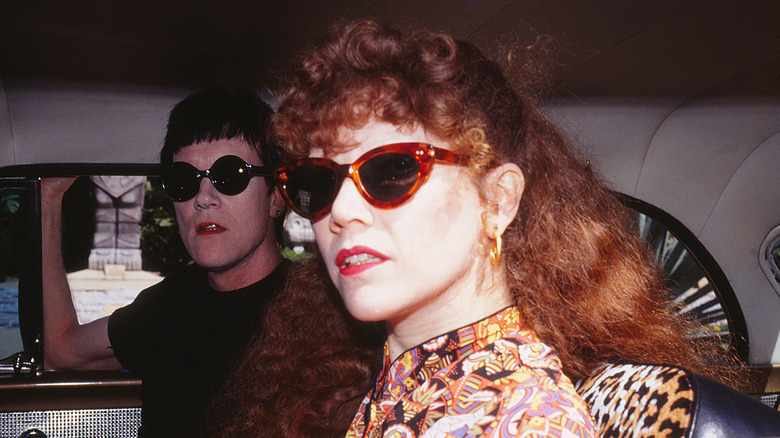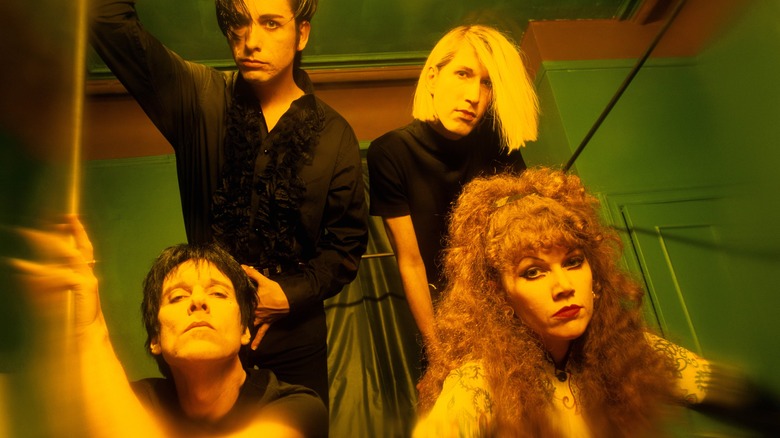The Untold Truth Of The Cramps
Rock 'n' roll, at its best, is a little bit scary — and no one understood that better than the Cramps. When Lux Interior and Poison Ivy (née Erick Lee Purkhiser and Kristy Marlana Wallace) founded the band in 1976, they knew they wanted to pay homage to the dark side of mid-century American culture — the schlocky B-movies, the horror comics, and the counterculture icons that they held so dear. They peppered lyrics to hits like "Human Fly," "I Was a Teenage Werewolf," and "What's Inside a Girl" with goofy innuendo and clever allusions to films shot in the '50s. They wore latex and tall boots. They rolled around, howled, and did everything short of performing circus stunts onstage. When they took their act to venues across the country, they won the hearts of countless misfits who were just as wild about retro aesthetics and self-expression as they were.
Itching to learn more about "the witchiest band to ever do it" (as they were once dubbed by Garage)? Read all about them below.
Lux Interior and Poison Ivy were married
Watch any Cramps video, and you'll notice the chemistry between Lux Interior and Poison Ivy. Not only were they creative collaborators, they were a bonafide rock 'n' roll couple. The two met in 1972 and remained lovers until Lux's 2009 passing.
When Lux and Ivy first crossed paths, they were college students at Sacramento State. According to a 1998 interview with the Independent, Ivy was trying to hitch a ride to her apartment when she caught Lux's eye. "She was walking down the street, hitch-hiking, and she was wearing a halter top and short shorts," he recalls. Ivy thought Lux was a stunner, too: "He was extremely exotic. He would have these pants and each leg of the pants was a different colour." Yet they didn't truly connect until they took a class called "Art and Shamanism" together. Lux took the empty seat next to Ivy, and their romance began. Soon Ivy was suggesting they start a band — and Lux was game.
Lux and Ivy seemed just as enamored with each other in the '90s as they were in the '70s. 'Til the end, they only spoke of each other kindly. "He's easy to love ... [When I met him], I thought: 'Oh boy, what's gonna happen now? Something exciting!' It's still happening," Ivy says in the interview. Lux sings her praises in turn: "She's really courageous and she's really smart ... There's a million sides to Ivy and I just love all of them."
They're considered the progenitors of the 'psychobilly' genre
The Cramps' music is often referred to as "psychobilly," a term derived from "rockabilly" (one of the earliest styles of rock 'n' roll music). According to an interview with Poison Ivy in the book "We Got the Neutron Bomb: The Untold Story of LA Punk," (via Far Out) the band first described themselves as such on promotional flyers that they passed out in the 1970s.
The Cramps never intended to name an entire subgenre of music, let alone create one. Yet their impact on the rock scene led to a wave of bands who either self-identified as "psychobilly" or were labeled "psychobilly" by the press. "The Cramps weren't thinking of this weird subgenre when we coined the term 'psychobilly' in 1976 to describe what we were doing," Ivy specifies in the interview. "To us all the '50s rockabillies were psycho to begin with; it just came with the turf as a given, like a crazed, sped-up hillbilly boogie version of country. We hadn't meant playing everything super loud at superheavy hardcore punk tempos with a whole style and look, which is what 'psychobilly' came to mean later in the '80s."
In a feature for Far Out, journalist Mick McStarkey lists some of the hallmarks of psychobilly as "minimal drumkit," "dual guitars," "campy humour," and "sexual references." Some of the artists who influenced the genre, he notes, include Link Wray, Screamin' Jay Hawkins, Dick Dale, and The Standells.
They 'cut their performing teeth' at CBGB
According to Please Kill Me, Lux Interior and Poison Ivy moved to New York City in 1975. There, they joined forces with guitarist Bryan Gregory and drummer Pam Ballam and formed the Cramps. They "cut their performing teeth" playing at CBGB, the city's legendary punk club.
Dick Porter writes about the Cramps' CBGB days in his book "Journey to the Centre of The Cramps." The Dead Boys, Richard Hell, and Suicide were just some of the acts who regularly shared the stage with them. Visiting artists from out of town, such as the Runaways, the Dickies, the B-52s, X-Ray Spex, and Squeeze helped keep the scene lively. Sometimes bands who had dominated the CBGB scene earlier in the 1970s would stop by as well. "We never did fit in there, except that every place we played they had to turn people away. The whole scene was really fun. I loved the Ramones and Talking Heads and Blondie. We had a good time with them," Lux remarks in the book, looking back.
The Cramps were frustrated by the fact that they were sometimes taken as a parody band due to their throwback sound and spooky aesthetic. Yet they drew major crowds — they could fill up the floor three or four nights in a row. Many of their fans thanked them for expanding their musical consciousness by serving as their gateway to the rockabilly greats of yore.
They were known for their onstage antics
In the tradition of Iggy Pop, Lux Interior quickly became notorious for his wild behavior on stage. As noted by NME, he often spent his shows writhing on the floor and stripping with a showman's gusto. One of his regular tricks, Far Out recounts, involved sticking the head of a microphone into his mouth and sliding it down his throat in a sensual gesture — a maneuver known as his "microphone blow-job."
Sometimes, Lux's antics were even more extreme. According to a Guardian article that affectionately refers to him as "a twisted Elvis from hell," he allegedly once masturbated on stage, climaxing during the final song of the set. Another night, he paraded around the venue in leopard-skin briefs before stopping to drink wine from an audience member's shoe. He promptly outdid himself by making out with another audience member for a full ten minutes, his infamous microphone wedged between both of their mouths.
Many of their songs were covers of '50s classics
Throughout their career, the Cramps often paid their respects to the rock 'n' roll greats who came before them. In fact, their first single was a cover of a '50s hit — "Surfin' Bird" by the Trashmen. According to "Journey to the Centre of The Cramps," Lux and Ivy chose the song because of the ethos it encapsulated. In an interview, Lux explains, "Our first song was 'Surfin' Bird' and a lot of times we ended our set with that. I think that really stands for something in the history of rock 'n' roll — not just our version, but that song in particular ... The great thing about songs like 'Surfin' Bird' is that they're beyond art — beyond good or bad. Rock 'n' roll is bigger than just records, it's a way of life — you don't even need music to have rock 'n' roll."
"Surfin' Bird" wasn't the only cover the Cramps released. They also put their own spin on "The Way I Walk" by Jack Scott, punctuating the verses with shrieks to give it some B-movie flavor. Other songs they covered include Jimmy Stewart's "Rock on the Moon," Dwight Pullen's "Sunglasses After Dark," Elvis Presley's "Jailhouse Rock," the Sonics' "Strychnine," and Little Willie John's "Fever."
They were truly passionate about B-movies
It's clear to any casual listener that the Cramps were wild about all things kitsch and creepy. Lux, Ivy, and their cohort didn't just have a passing interest in horror and sci-fi tropes — they were serious connoisseurs of genre. According to an archived interview with now-defunct magazine City Limits (via Louder than War), Lux and Ivy had "3000 films on video tape" and were always looking to add to their collection.
In a 1990 interview with Dutch radio station VPRO (via Dangerous Minds), Lux and Ivy elaborate on their love of B-movies. Lux is quick to share his fondness for the films' DIY nature. There was something far more real to them because they were obviously amateur projects — a reality that you just didn't get from big, professional studios. "You're actually seeing people who can't act very well, so you see them as people," he explains, "and they usually take place in somebody's real house and on real streets and things, while all the other movies were being made on sets. There's a slice of reality you don't get in regular movies with those."
Poison Ivy notes that many of the Cramps' song titles and lyrics come from B-movies. "'Hot Pearl Snatch' is the name of a movie. 'All Women Are Bad' is the name of a movie. They're powerful titles to us enough that we felt like writing songs about them."
They were also inspired by modernist art
The Cramps typically liked to draw upon lesser-known B-movies for inspiration, but they weren't beyond looking to more highbrow works of art every now and then. Believe it or not, their track "Naked Girl Falling Down The Stairs" is not about a wild scene from a sexploitation flick but a Modernist work of art — specifically, "Nude Descending a Staircase, No. 2," painted by French artist Marcel Duchamp in 1912. According to Genius, although the abstract piece seems tame by today's standards, Duchamp's work caused quite a stir when he emerged onto the art scene. It's no wonder that a band as daring as The Cramps would admire him for his audacity.
"Naked Girl Falling Down The Stairs" begins simply enough. Upon visiting a museum, the narrator notices a crowd gathered around a painting. He then realizes that the painting depicts ... well, a naked girl falling down the stairs. Throughout the rest of the song, he expresses his shock: "Yeah, it was a naked girl right in my face/ High class culture all over the place."
Their most legendary show took place at a mental hospital
The Cramps were able to sell out legendary rock clubs like CBGB with ease — but they also played some less conventional venues. In fact, as journalist Phil Barber recounts in a Vice article, their most historic concert took place at the California mental hospital known as Napa State.
How exactly did this strange show come to be? The story isn't actually that wild: Bart Swain, an activities specialist for Napa State in the 1970s, was in charge of hiring musical acts to play for the patients when he received a call from Howie Klein, an organizer in the San Francisco punk scene. Klein told Swain that he had a band called the Readymades that would play at the institution for free. Swain agreed enthusiastically, committed to introducing the patients to a variety of genres. It's unknown why the Readymades were swapped out with the Cramps — along with the Mutants, a San Fran punk band — but Swain decided to go with the flow and let them play.
When the Cramps finally took the stage, they treated the show like any other. Only one video of the performance exists. "The Cramps make no attempt to pacify their mentally ill admirers," Barber writes of the tape. "Nor do they wink at some inside joke. They just rip." Addressing the crowd, Lux says, "Somebody told me you people are crazy, but I'm not so sure about that. You seem to be all right to me."
Lux Interior had a secret cameo in Francis Ford Coppola's Dracula
Lux Interior has always had a vampiric aura about him, considering his pale skin, dark hair, and love of the macabre. It only makes sense, then, that (as reported by Far Out Magazine) the rockstar has a brief cameo in "Bram Stoker's Dracula," directed by Francis Ford Coppola in 1992.
In the film's opening scene, Count Dracula — not yet undead — returns from a war to discover that his wife has committed suicide in a church after a cruel ploy by his enemies. He rejects his Christian faith, desecrating the altar, and subsequently turns into a vampire. As he realizes what has become of him, he raises his eyes to the heavens and lets out a piercing wail. Although this wail seemingly comes from the lips of Gary Oldman (who plays the titular monster), it was actually recorded by Interior. How did this come to be? Legend has it that Sofia Coppola, Francis Ford Coppola's daughter (and a director and actress in her own right), suggested the cameo to her father.
Lux Interior also appeared on SpongeBob SquarePants
With their outrageous onstage antics and notoriously sexual lyrics, the Cramps weren't exactly what you would call "kid-friendly." Hence, it might come as a surprise that they once guest starred on one of the most famous children's cartoons in TV history: "SpongeBob SquarePants."
According to Far Out Magazine, the band appears in the 51st episode of the show, titled "Party Pooper Pants," which first aired on May 17, 2002. Here, they portray a puppet punk rock group called "The Bird Brains." (It should be noted that the frontman looks suspiciously like Lux Interior, boasting jet-black hair and stylish shades.) The Bird Brains are beloved by Potty the Parrot, so when it's time for him to find entertainment for Patchy the Pirate's house party, he jumps at the chance to hire them. Everyone loves their raucous performance — except for Patchy, who gets blasted out of his home by the sheer volume of their music. The episode sees them performing a new song — "Underwater Sun," written and composed by Stephen Hillenburg and Peter Strauss.
By all accounts, it seems the Cramps got along with the show's cast. When Lux Interior died in 2009, Tom Kenny, the voice of SpongeBob, attended his memorial ceremony.
The whole band made an appearance on Beverly Hills, 90210
The Cramps' appearance on "SpongeBob SquarePants" wasn't their only TV spot. According to Far Out Magazine, they also popped up on a Halloween special of '90s teen drama "Beverly Hills, 90210." Titled "Gypsies, Cramps, and Fleas," the episode showed the band performing two songs onstage at a costume party — first "Mean Machine" and then "Strange Love." The brief cameo is a treat for all fans. First, Lux Interior shouts, "Hey, boys and ghouls, are you ready to raise the dead?" Then everyone goes wild as he does his signature strut and Poison Ivy strums away.
How did this unlikely collaboration come together? All is revealed in an interview with producer Larry Mollin, who was the one responsible for many of the show's musical guest stars. "I come from a rock and roll background so I was always bringing in stuff," he says. Other bands who were invited to the show by Mollin include The Flaming Lips and the Goo Goo Dolls.
They've inspired a host of other bands
In 2009, Lux Interior died of an aortic dissection. His passing marked the end of the Cramps — at least, in the literal sense. The band inspired countless other acts throughout its 30-plus years of existence; on top of that, it continues to captivate fans the world over. Considering their footprint in the rock music scene, the Cramps will live on for years to come.
Kevin Shields, best known as the vocalist and guitarist of My Bloody Valentine, is just one of the many musicians who has cited The Cramps as an influence. According to a 2021 Guitar World article, he once said that the Cramps inspired him to form his band. Josh Homme is another longtime fan. His band Queens of the Stone Age covered the Cramps song "The Most Exalted Potentate of Love" in 2002; in 2004, according to SF Weekly, his other group — Eagles of Death Metal — had the exciting opportunity to open for the Cramps' Halloween concert at the Warfield in San Francisco. In 2018, Homme's love for the band was still going strong — per Revolver, he included some of their music in a playlist he curated for the Halloween episode of his Apple Music Beats 1 show, "The Alligator Hour."
Ian MacKaye of Minor Threat and Fugazi also counts himself among the Cramps' admirers. According to an interview with Loud and Quiet, he credits a particularly rowdy Cramps show in '79 with starting the D.C. hardcore scene.
